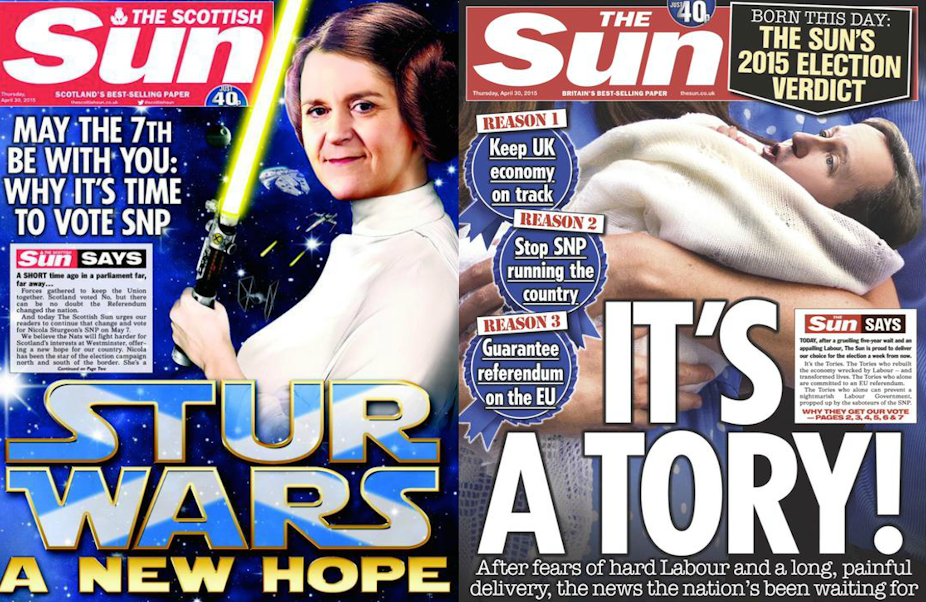It’s the news “the nation has been waiting for” exclaimed The Sun in its front page editorial, and “it’s a Tory!”
The British red-top tabloid famous for the now-defunct topless page three models, has traditionally claimed to have influenced election outcomes. This year it called on its readers to vote Conservative to keep the UK economy on track, guarantee a referendum on the EU, and stop the Scottish National Party running the country.
But there’s a twist. Somewhat bizarrely, its Scottish edition backed the SNP in its front page editorial, declaring party leader Nicola Sturgeon represented “a new hope” for Scotland.
The question is, though, does it matter? Do newspapers ever really influence elections? And for all the bluster, will the cries from the newspapers make a blind bit of difference?
The campaign to date has been relatively uninspiring, and intensely stage-managed. Local media have complained they have been ignored, and in some cases locked out of events, while the major parties toured the country. Squabbles over who won the debates and minor gaffes – such as when the prime minister David Cameron forgot which football team he supported – have received much coverage, while there has been relatively little substantive debate in the national press on important issues such as the economy or healthcare.
Labour and the Conservatives have appeared happy to play along – with everything to play for, both are desperate to avoid a Mrs Duffy moment, a reference to 2010 when former prime minister Gordon Browne was recorded making disparaging comments about a woman who had challenged him while campaigning.
All the while, the main newspapers have attempted to set the agenda. The “Red Ed” narrative pushed by The Daily Mail has seen daily attacks on Labour and its leader Ed Miliband. The left-leaning Daily Mirror attacked the Tories on several occasions on its front pages, warning of the dangers of continued Conservative government.
Some of the more eye-catching headlines have included The Sun’s White Van Man Backs Cam, The Daily Mail’s Red Ed’s politics of the Banana republic’ and The Daily Telegraph’s 5,000 small business owners supporting David Cameron. The Guardian later reported the letter was orchestrated by the Conservative party – with meta-data showing it was authored at Conservative party headquarters.
But for all the bluster, the partisan reporting appears to have had little impact on the campaigns; both Labour and the Conservatives are locked in the low to mid-30s in terms of party support and polls are predicting neither party will have enough seats to form a government alone.
So why are the parties so keen to court the press? There are two diverging views of the importance of newspapers in setting public opinion and influencing elections – the agenda-setting view (newspapers set agendas and influence opinion) and the reinforcement view (papers tend to reinforce views their readers already hold) – many studies which find that in some cases newspapers set the agenda, but in other cases newspapers are an echo chamber for the broadly shared views of readers.
For example, one 2010 study after the last election found that 59% of Daily Mirror voters voted Labour, and just 16% voted Conservative. For The Daily Telegraph readers, 70% voted Conservative and only 7% voted Labour.
An important study in 1999 by the Centre for Research into Elections and Social Trends at the University of Oxford found that newspapers do have some influence on individual voter choices, but relatively little influence in the overall outcome of results, partly because of the highly partisan and non-homogenised nature of the British press.
So no newspaper can ever have claimed (despite what The Sun might say) that any of them ever “won it” for any government. Newspaper readers tend to vote for parties that broadly represent their interests, in the same way they buy newspapers that broadly speak to their interests.
In the digital era, then – and at a time when newspaper circulation is rapidly declining – it is not surprising that all the political parties have invested heavily in social media campaigns.
All the parties know that in the relatively fertile ground of the online world, in particular social media, opportunities to influence potential voters are many. The 2008 and 2012 Obama campaigns depended heavily on social media (as well as digital resources such as big data to hone their message and to organise and mobilise their campaign teams).
With the growing influence of social networks, voters are as likely to take their cues from peer groups than from traditional news media. Newspaper readership is declining, as are television audiences – especially among younger viewers – for news and current affairs. In the digital world, peer-sharing of content is king.
Various surveys following the 2010 British elections showed that engagement and commentary by 18 to 24-year-olds occurred mainly on social networks. That cohort are an age bracket older now, and have been joined by a new group of young voters. In the UK, 47% of adults use social networks such as Twitter and Facebook – a lalrge proportion the 42m people who use the internet.
So if 2015 proves to be “the year when social media won it”, why are the parties still courting the press? And why are newspapers making such a song and dance about who they support? There are many reasons and no clear-cut answers. The British media tends to latch on to issues, so the agenda-setting role is still strong (we just have to think of the 2009 MPs’ expenses scandal as a case in point).
But it’s also the case that this is a campaign where margins are won by inches. No party will be willing to take a chance and abandon newspapers altogether, even if their influence has dwindled significantly.

